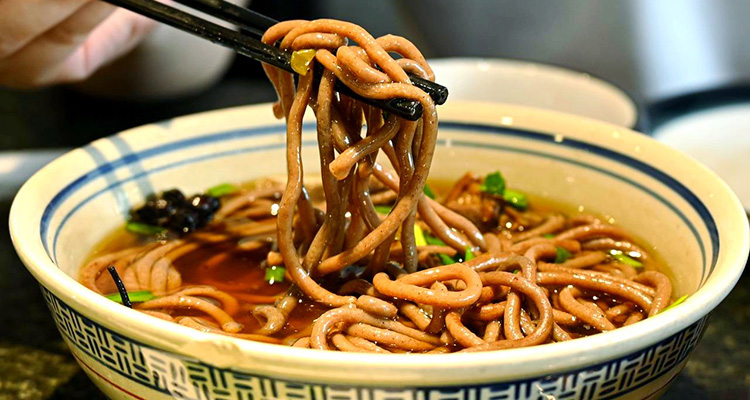Wuji Buckwheat Noodles: Authentic Hebei Northern Chinese Specialty
When a steaming bowl of Wuji Buckwheat Noodles is served, the dark brown buckwheat noodles swirl in a rich, milky bone broth, dotted with fresh green cilantro and tender yellow egg strips. This simple yet unforgettable dish awakens the taste memories of northern China! Take a sip of the savory broth first, then pick up the chewy noodles— the unique aroma of buckwheat fills your mouth, like golden waves of wheat rippling across the Hebei plains.
1. Origin and History
Wuji Buckwheat Noodles originated in Wuji County, Hebei, with a history of over 600 years. Originally, local farmers made it as a festive food to celebrate the harvest. Over time, thanks to its unique taste and preparation method, it became a staple daily dish. This noodle dish reflects the farming culture of the central Hebei plains and is an important symbol of northern Chinese noodle traditions.
2. Cultural Significance
For the people of Wuji, these noodles symbolize reunion and celebration. During important festivals or family occasions, every household prepares them as a gesture of “harmony and happiness.” This dish carries the hopes for a good life and is a warm, nostalgic memory for locals and travelers alike.
3. Key Ingredients
High-quality local buckwheat from Wuji is essential, mixed with a small amount of wheat flour for elasticity. The broth is made by simmering pork bones and chicken frames for over six hours. Toppings include cilantro, shredded egg, and minced meat. The most special touch is the locally-made chili oil, which gives Wuji Buckwheat Noodles their signature soul.
4. Preparation Process
First, knead the buckwheat flour into dough, then press it into strips using a traditional Wuji noodle press. Boil the noodles for three minutes, then immediately rinse in cold water. In a bowl, add seasonings, pour in the hot bone broth, place the noodles, and top with the prepared ingredients. Precise timing and heat control are key to perfect results.

5. Flavor and Texture
The noodles are smooth and chewy, with the characteristic fragrance of buckwheat. The first bite brings the rich flavor of the bone broth, followed by the spiciness of chili oil, finishing with the subtle sweetness of buckwheat lingering on the palate. Each layer is distinct yet harmoniously blended, leaving a lasting impression.
6. How to Eat
The traditional way is to drink the broth first, then eat the noodles, and finish by savoring the remaining soup. Locals often pair it with a side of raw garlic cloves, which enhances the noodles’ flavor. Some prefer adding a splash of aged vinegar to make the soup taste fresher and more appetizing.
7. Where to Taste
You can find authentic Wuji Buckwheat Noodles at local “Old-Brand Noodle Shops” (around 15–25 RMB per person) or “Wuji Noodle Family” (around 12–20 RMB per person). The best time is during lunch or dinner, and you can request “extra spicy” when ordering.
8. Tourist Tips
The dish can be referred to in English as “Wuji Buckwheat Noodles.” If you’re not used to the strong buckwheat flavor, ask for extra toppings. The broth can be refilled for free—don’t waste this flavorful essence. Autumn and winter are the ideal seasons to enjoy it.
9. Easy Home Version
At home, you can use store-bought buckwheat noodles instead of handmade ones and chicken broth instead of bone broth. While it won’t be as authentic as the traditional method, mastering the seasoning ratio allows you to enjoy most of the dish’s charm in your own kitchen.
Stroll through the streets and alleys of Wuji to find this bowl full of hometown nostalgia! When the chewy noodles dance on your tongue and the rich broth warms your heart, you’ll understand why this simple dish remains a forever favorite in Wuji. On this fertile plain, let Wuji Buckwheat Noodles take you on a journey through the most authentic northern Chinese noodle culture!


